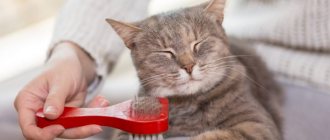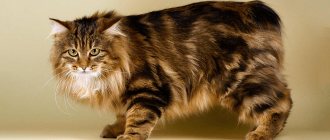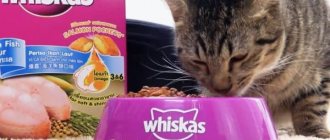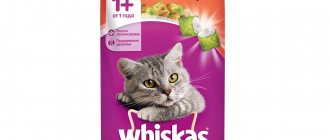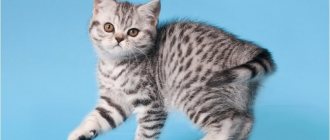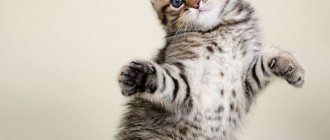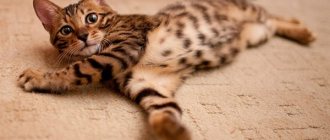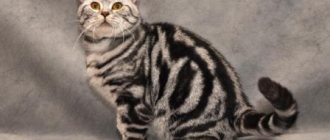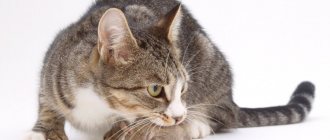Why is Whiskas the cat so popular?
Not all people are loyal to advertising on television or on the Internet. But, whatever one may say, it has become an integral part of the life of a modern person. Advertising is a time when the human brain perceives information primarily superficially, that is, literally lets it pass by.
Many people like the cat from popular advertising
But who doesn’t stop their gaze on the screen when the face of everyone’s favorite animal appears there? This adorable cat from a cat food commercial has won the hearts of viewers. Its characteristic, memorable color has long branded all cats of this breed as the “Whiskas cat.”
Types of tabby
Tabby (or tabby) coloring suggests the presence of a zonal pattern. This could be the letter “M” on the forehead, eyeliner on the nose and eyes, a necklace on the chest, rings around the ponytail and paws, highlighted spots on the back of the ear and curling patterns on the cheeks. The standards dictate that all stripes should have a small width, and in merle colors there should be a smooth, gradual transition into spots, which then form patterns on the cat’s belly and neck. The pattern is often very bright and stands out well against the base background, often contrasting with him. The tip of the nose and eyes appear slightly circled.
Tabby color types are divided according to the following principles.
- Tiger (aka mackerel) - has vertical, narrow, distinct stripes on the sides. On the neck the pattern forms something like a wide collar, the tail is striped. The stripes on the sides rise higher and on the back form a pattern that is somewhat reminiscent of a saddle.
- Spotted refers to the presence of spots of various shapes and sizes, but the contours of such spots are usually very clearly defined. Along the spine, the spots may create a line that runs from the head to the base of the tail, which is also covered in stripes. There are also spots on the stomach, but much smaller in size.
- Marbled (shaded, whiskas) - a pattern of spots and stripes scattered randomly throughout the coat. Representatives of this variety can have almost any color, but the distinct pattern will always provide a bright visible contrast with the base shade. This breed got its name because its coloring is a bit like the patterns on well-polished marble.
- Silver. The main background is silver, the patterns are black.
- Silver blue. With snow-white undercoat, sides, face and tail.
- Red. Light red base with patterns of deep red tones.
- Brown. A shade of old, darkened copper with a black pattern.
- Blue. The base is cream or blue tones, the pattern is rich.
- Cream. The base is very light, creamy, the pattern is much darker, maybe beige.
- Tabby cameo. The base is snow-white with stripes of red tones.
The history of whiskey color
There is no official coloring of whiskey.
Whiskas color has its own name - tabby. Known for a long time and is basic. The ancestors of domestic cats had exactly this color. The word “tabby” has English roots and refers to silk fabric with moire patterns.
Tabby coloring occurs only in cats.
It received the name “Whiskas” for an advertisement for the pet food of the same name, in which a perky British tabby kitten plays enthusiastically. Thanks to this advertising, it gained both its name and great popularity.
The Whiskas color was named after an advertisement for the food of the same name.
Where to buy the kitten from the Whiskas advertisement
Bombay cat - description of Bombay cats
Today, buying a cat as advertised is not a big problem. Advertising contributed to the popularization of the breed. It is noteworthy that kittens of different breeds took part in various videos. So, for example, when buying a kitten from a Whiskas advertisement, you can choose from British, Scottish, American and European shorthairs. Outwardly, they are not much different from each other and will become family favorites for many years.
List of some popular nurseries engaged in breeding cats of these breeds:
- Al Blues (St. Petersburg);
- Allure (St. Petersburg);
- Hope Island (St. Petersburg);
- Sandi-Cat (St. Petersburg);
- Astropuss (Moscow);
- Britanic (Moscow);
- Brittish House (Moscow).
British Shorthair kittens are the most popular among breeders
Varieties of chinchilla colors
The appearance of chinchilla colors is based on an already familiar concept - tipping. These varieties are characterized by the color of approximately one-eighth of the hair, while most of it remains snow-white.
There are three types of chinchillas: silver, gold, and the unique, and therefore valuable, blue golden chinchilla. Silvers may have outlines on their tails - “shadows” of stripes. The eyes are green, the nose is beige. The snow-white undercoat looks a bit like gray hair showing through. The tips of the ears, chin and belly are snow-white.
The golden chinchilla has a reddish tint on the back, tail and sides. Unlike the golden one, the blue golden chinchilla has an undercoat that resembles the color of melted milk (delicate, light caramel), and the fur is colored blue with a radiance. The eyes have a rich green color and resemble large clear emeralds.
Features of British Shorthair
The history of coexistence between humans and British shorthair cats stretches back to time immemorial. It was precisely these years of strength testing that made the “British” both an excellent hunter and a loving pet.
Hairless cats: history of the breed and maintenance features
They are quite unpretentious and only need sufficient communication and attention from the owner. The character is calm and flexible. Their fur is not long, and the thick undercoat makes the animal look like a plush toy. The average hair length is 2.4 mm. The undercoat must be brushed regularly.
For your information! In terms of density and delicacy of a cat's fur, it can only be compared with the fur of a bear.
British cat character
These are real aristocrats . They walk slowly, do not make noise, can lie in one place for a very long time, they are unhurried and very clean, unpretentious in care.
It is almost impossible to find an adult British cat running around the house at the speed of light or riding on the curtains. All these cat pranks take place in their childhood. Their English upbringing does not allow them to jump on cabinets, peel off wallpaper and sharpen their claws on their owner’s favorite sofa. Due to their short fur, they practically do not shed.
They don't need to be educated. Even as a kitten, learning from their mother cat, the British will go to the toilet and sharpen their claws only in the place designated for this. If the cat wants to eat, he will come to his plate and sit there quietly until he is fed, without making unnecessary sounds. In general, they meow very rarely, only in cases of extreme necessity, for example, when they have to wait too long for their favorite treat.
The Briton is an ideal pet with virtually no flaws.
- calm friendly character
- cozy softness of fur,
- cutest appearance,
- many varieties of colors,
- ease of care.
Home care
Fold-eared pets do not require special care. Periodically you need to examine your eyes and remove accumulated mucus in the corners of the eyelids using cotton wool. It is necessary to keep your ears clean by regularly removing wax with cotton swabs and wiping the inner surface of your ears with a cotton swab soaked in hydrogen peroxide, clean water or a special lotion.
Caring for Scots requires mandatory combing and trimming of nails. You should brush your cat at least once a week. You can use a fine-tooth comb or a natural-bristled brush.
Nails should be trimmed if your pet does not have time to sharpen them on his own. Scots should be bathed as rarely as possible. They themselves take good care of the cleanliness of their fur. Frequent bathing with special shampoos deprives the cat of its protective layer, which negatively affects the condition of the animal’s hair.
It is better to give your cat ready-made food of high quality. You should not feed your pet Whiskas. With natural feeding, the diet should be varied in order to provide the cat with useful substances; vitamins and minerals must be given. How long Scottish Fold cats live depends largely on their diet. According to reviews from many owners, their lop-eared pets are unpretentious in food.
Features of pet care
The British Shorthair cat needs to be brushed regularly, without using a comb brush.
Grooming is more difficult. The plush fur of the Briton needs to be combed two to three times a week (and during periods of intense shedding every day) with a medium-frequency metal comb with rounded teeth, first in the direction of hair growth, and then against it.
After this, dead guard hairs are removed using a natural bristle brush or a mitten with a pimply rubber coating, massaging the cat against the grain.
Puffers are not used to groom British cats, since they remove the undercoat and make the coat less voluminous, depriving cats of their main decoration.
Approximately once every two or three weeks, it is recommended to use dry shampoo while combing, and then grooming powder to clean the coat of dust, give it volume and strengthen the hair structure.
But even if you brush your cat regularly, when licking it, it will still swallow hair. Inside the stomach, the hairs roll into dense lumps, which at best come out with vomit, and at worst cause intestinal blockage. For other cats, eating fresh grass is usually enough to remove these lumps (bezoars), but the British cats have denser lumps due to the thickness of their undercoat.
Therefore, once every two months (and even more often during molting), cats need to be given a special paste to dissolve ingested hair.
But there are no particular difficulties in feeding British cats. Just like any other cat, they are recommended to be given high-quality dry or canned food (for example, Royal Canin, Hills, Jams, Acana, but not Whiskas and similar economy-class food!) or balanced natural food, including meat, offal, cereals, vegetables, dairy products.
To the question: “which is better?” difficult to answer; Breeders and veterinarians have been arguing about this for years. In my opinion, a complete natural diet is healthier than dry food, but not every cat can be forced to eat cereals and vegetables, and not every owner has the time and desire to prepare “first, second and compote” for their pet.
This is how they are, Whiskas cats - beautiful, smart and full of character. And thanks to the successes of Russian breeders, now in almost every large (and not so large) city you can buy kittens of this breed of different colors for a very reasonable amount, and the “whiskey” one is one of the most favorite among them. But still, before you buy a baby, weigh all the pros and cons and get serious. Fashion will pass, but a living creature should live happily next to you throughout its long life.
KotoDigest Thank you for subscribing, check your inbox: you should receive an email asking you to confirm your subscription
The British Shorthair's short coat with a thick undercoat requires special care. It is necessary to comb three times a week. During the molting period, even more often. A cat can do this on its own. But villi that get into the stomach cause problems in the gastrointestinal tract. The way out is to give a special paste that dissolves the hairs and removes them naturally.
READ Weimaraner dog
